Takao Sightseeing Spots
We introduce the main tourist spots of Takao.
- Takaosan Jingoji Temple
- Makinoosan Saimyoji Temple
- Toganoosan Kosanji Temple
- Hiraoka Hachimangu Shrine
- The Arashiyama-Takao Parkway
- Kitayama Cedar Trees
Takaosan Jingoji Temple
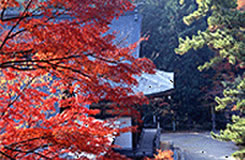
Visiting Jingoji Temple
The mountain ridge of Takao is known as one of the three greatest mountain ridges in Kyoto. It is a pleasurable location for an excursion in the suburbs. The vast precincts of Jingoji Temple (formally called “Takaosan Jingoji”) are covered with greenery, including maple leaves that turn red in autumn. The Kondo (Main Hall) in vermillion competes for its color with the red maple leaves. The Daishido Hall has been quietly enduring the windy snow for the last seven centuries, and the multi-storied pagoda rises over the greenery. The beauty of these sites cannot be drawn with a paintbrush. Kinunkyo, a valley formed by the clear stream of the Kiyotaki River, can be seen from the garden at the westernmost end of the precincts. It is a steep-walled valley, where people enjoy kawarake nage, which involves throwing an unglazed or sunbaked earthen sake cup or dish from a high place and making a wish for protection from evil. One cannot predict the destination of the kawarake. The mountain is fully decorated with cherry blossoms in spring. Visitors can hear the outburst of cicadas in the morning and the croaks of kajika frogs and the buzz of clear-toned cicadas before sunset in summer. Everything is buried in the snow in winter. Surrounded by the beauty of nature through the four seasons, it is a good environment to think about the nature of human beings.
- Address
- 5 Takao-cho, Umegahata, Ukyo-ku, Kyoto 616-8292
- TEL
- TEL:075-861-1769
FAX:075-862-0354 - Opening hours
- Opening hours of Main Hall: 9:00 AM to 5:00 PM (last acceptance at 4:00 PM)
(The Main Hall is closed to visitors from December 29 through 31 in preparation for the New Year.)
List of Treasures of Jingoji Temple (Abstract)
National Treasures
- A wooden statue of Bhaisajyaguru as the principal image of the Main Hall (Open to the public on a regular basis)
- Portraits of Minamoto no Yoritomo and Taira no Shigemori (Open to the public from May 1 through 5)
- Five wooden statues of Akasagarbha placed in the Multi-storied Pagoda
- The Mandala of the Two Realms, painted in gold and silver on dark bluish-purple damask (two scrolls)
- The image of Gautama Buddha (a colored silk scroll)
- Two panels of Rokaku Sansui-zu (Landscape of High Buildings)
- Kanjo Rekimei (a record list of the Ganjo - an important ceremony in the esoteric Buddhism) by Kobo Daishi, a Japanese Buddhist monk
- Bronze Bell (written by Fujiwara no Toshiyuki), important cultural property
- A statue each of Suryaprabha and Candraprabha Bodhisattvas placed in the Daishido Hall
- An illustration of Jingoji Temple
- Four illustrations of Jingoji precincts
- A wooden standing statue of Vaisravana
- Sonsho Mandala (a scroll)
- The image of Twelve Divas (12 colored silk scrolls)
- The Donation made by Emperor Gouda (a scroll)
- A draft of a letter written by Priest Mongaku
- A History of Jingoji Temple with People Related
- Wake no Kiyomaro
- Dengyo Daishi, posthumous title of Saicho (a Japanese Buddhist monk)
- Kobo Daihi, posthumous title of Kukai (a Japanese Buddhist monk), and Mongaku Shonin (Japanese Buddhist mon)
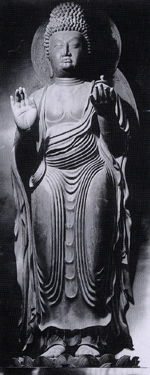
A wooden statue of Bhaisajyaguru as the principal image of the Main Hall 
Portraits of Minamoto no Yoritomo and Taira no Shigemori
Makinoosan Saimyoji Temple

Saimyoji Temple (formally called “Makinoosan Saimyoji”) belongs to the Kogi Shingon sect of Buddhism and the sango of the temple (the honorific mountain name prefixed to the temple’s name) is Makinoosan. Makinoosan Saimyoji Temple, Takaosan Jingoji Temple, and Toganoosan Kosanji (also known as Kozanji) are known as the famous temples of the three greatest mountain ridges. Since ancient times, Makinoosan Saimyoji Temple has been richly surrounded by nature, including the clear Kiyotaki River and seasonal splendor: cherry blossoms and azaleas in spring, fresh greenery in early summer, red leaves in autumn, and snow scenery in winter. It is said that Chisen Daitoku, a leading disciple of Kukai (also known as Kobo Daishi, a Japanese Buddhist monk), established Makinoosan Saimyoji Temple as a branch of the Jingoji Temple during the Tencho period (824-834). The temple later fell into ruin but was revived by Priest Gaho Jisho of Makinoosanji Temple in Izumi Province in the Kenji period (1275-1278), during which time the Main Hall, Sutra Hall, Pagoda, and guardian shrine were built. In addition, the title of Byodo Shinnoin was granted by Cloistered Emperor Gouda in 1290, and the temple became independent from Jingoji Temple. The temple was later destroyed by fire in the Eiroku period (1558-1570), but was rebuilt in 1602 by Myonin Risshi, a Buddhist priest. The current Main Hall building was rebuilt in 1700 using funds donated by Keishoin (mother of Tsunayoshi, the 5th Shogun). Many Buddha statues, including the statue of Gautama Buddha (an important cultural property) as the main object of worship, are enshrined on a platform called karayo shumidan.
- Address
- 1 Makinoo-cho, Umegahata, Ukyo-ku, Kyoto 616-8291
- TEL
- 075-861-1770
- Opening hours
- 9:00 AM to 5:00 PM
- Statue of Gautama Buddha
- Statue of Thousand-armed Avalokiteshvara
- Statue of Ragaraja
People Related
- Chisen Daitoku
- Priest Gaho Jisho
- Myonin Risshi
- Keishoin
Toganoosan Kosanji Temple
Only the Sekisuiin Hall is open to visitors. The precincts are temporarily closed.
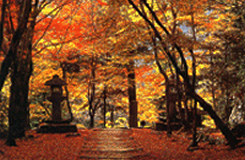
The Takao, Makinoo, and Toganoo ridges along Shuzan-kaido Road, which leads to Tamba Highland, are called the three greatest mountain ridges, and have been known for the scenic beauty of red autumn leaves. When you pass the road leading to the deep mountain Tamba area along the Kiyotaki River and visit Kosanji Temple (also known as Kozan-ji and formally called “Toganoosan Kosanji”) on a rainy day in the beautiful forest of Kitayama cedar trees, the atmosphere of the sanctuary will calm you down. The beauty of Kosanji Temple instills all four seasons directly into your heart. Above all, the autumn view of the evening moon over Mt. Mukai from the edge of the eaves of the Sekisuiin Hall is exceptional. It will stir your poetic imagination that has been forgotten in your daily life. The surrounding area of Kosanji Temple is covered with old cedars, giant pine trees, and old maple trees, and there are also many religious ruins, including a pagoda, and the entire area, including Mt. Ryoga, is designated as a national historical site. As Buddha’s teaching goes, “The colors of the mountains make Buddhist bodies, and the sounds of the valley streams make Buddhist sermons,” it has an environment that is truly suitable for the Avatamsaka Pure Land.
- Address
- 8 Togano-cho, Umegahata, Ukyo-ku, Kyoto 616-8295
- TEL
- 075-861-4204
- Opening hours
- Open to visitors (Main Hall): 8:30 AM to 5:00 PM
JR bus: Approximately 50 minutes from Kyoto Station to Toganoo bus stop
Approximately 40 minutes from Shijo Omiya to Toganoo bus stop
List of Treasures of Kosanji Temple
National Treasures
- Building: Sekisuiin Hall with Portrait of Priest Myoe Meditating on a Tree (light-colored painting on paper)
- Image of Buddhalochana (color painting on silk) and Choju Jinbutsu Giga (a monochrome ink painting paper scroll of caricatures of frolicking birds, animals, and humans)
- Kegon-shu Soshi Eden Rokkan (six color painting paper scrolls of pictorial biographies of the founders of the Kegon sect of Buddhism)
- Image of Manjusri Bodhisattva (color painting on silk)
- Shogun zuka-emaki (monochrome ink painting paper scroll)
- Kegon-Kaie-Shoshoju-Mandala (color painting on silk)
- Dry lacquered wooden sitting statue of Bhechadjaguru (sculpture)
- Statue of Zenmyoshin (sculpture)
- Statue of Byakkoshin (sculpture)
- Kasuga-Myojin’s Devine Deer (sculpture)
- Dream Diary (writing in ink on paper)
- Daito-Tenjiku-Riteisho (writing in ink on paper)

Building: Sekisuiin Hall with Portrait of Priest Myoe Meditating on a Tree (light-colored painting on paper) 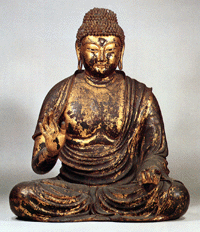
Dry lacquered wooden sitting statue of Bhechadjaguru (sculpture)
Hiraoka Hachimangu Shrine

Hiraoka Hachimangu Shrine was built on December 10 in A.D. 809 by the famous Buddhist priest Kobo Daishi (also known as Kukai) at the request of Usa Hachimangu Shrine. Kobo Daishi depicted an image of a Buddhist priest known as Sogyo Hachiman-shin as the guardian god of Takaosan Jingoji Temple, and it became the object of worship housed in the shrine Shinto (called “goshintai,” which is believed to contain the spirit of a deity). This is the oldest Hachimangu Shrine (a Shinto shrine dedicated to Kami Hachiman, an ancient Shinto god).
A special exhibition of Hana no Tenjo, or a flower ceiling, open at this shrine is especially popular with women. The shrine is located between Takao, Arashiyama, and Omuro. Above all, the quiet environment retains the old Kyoto atmosphere. Visitors can see the shrine, listen to and enjoy the Shinto priest’s explanation, and learn. In Kyoto, this is the only shrine where the priest gives guidance. The priest talks about the story of the hidden story of the flower ceiling, the secret of shimenawa (a rope used to cordon off consecrated areas or as a talisman against evil), and the proper method of making devotional visits to Shinto shrines.
- Address
- 23 Miyanokuchi-cho, Umegahata, Kyoto 616-8271
- TEL
- 075-871-2084
- Opening hours
- 10:00 AM to 4:00 PM (September 15 through December 3)
(However, no visitors are accepted on October 1, 8, and 9 due to the shrine’s Shinto ritual.) - Admission
- 500 yen (includes a historical records book and tea that is served with a rice cake stuffed with bean jam)
Guidance on Precincts
- Jishu Shrine for god of land
- Takeuchi Shrine for god of longevity
- Kifune Shrine for god of water
- God of healing
- Wakamiya Shrine for god of mind
- Rock of mountain god as the guardian of the mountains
- Hiraoka Hachiman Saraswati as goddess of the performing arts, music, and wealth
The Arashiyama-Takao Parkway
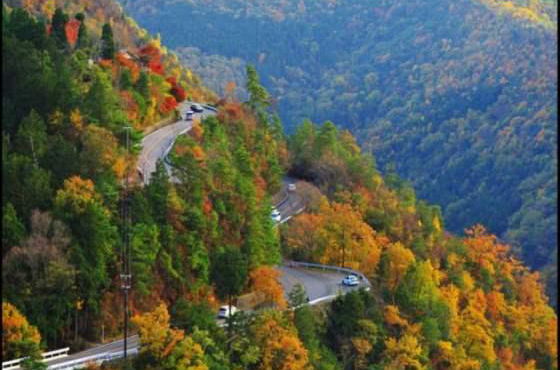
The Arashiyama-Takao Parkway provides beautiful views of the Rakusai area in Kyoto.
It is a 10.7-kilometer scenic highway connecting Arashiyama and Takao, which are known as the sightseeing mecca of Kyoto and a bounty of nature, respectively. This highway leads to the Ogurayama Observation Deck. It not only commands a view of the beautiful scenery of the area but, around it, can be found leisure facilities and an amusement park that you can enjoy with your family. The leisure area has a large parking lot that is convenient for exploring its vicinity.
The Ogurayama Observation Deck is open to visitors until 6:00 PM.
Introduction of Facilities

The Ogurayama Observation 
The Hozukyo Observation 
The Flower Park
Kitayama Cedar Trees
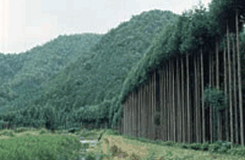
In Takao’s blessed natural environment, Kitayama cedar trees are carefully raised by afforestation professionals with their strict “eyes” and techniques that have been handed down from generation to generation over the years. From the careful selection stage of seedlings, they spend more than 30 years raising Kitayama cedar trees with efforts that would make most people nervous. They have to grow the seedlings into beautiful trees that are straight and clear from knots, with a certain thickness. Generally, it is easy to grow thick and straight trees, but it is difficult to grow thin and straight trees like the Kitayama cedar trees. Above all, advanced techniques are required to grow them into trees with a proper circumference and clear of knots. The purpose of pruning work, which is one of the typical features of the Kitayama area, is to create beautiful trees without knots. At the same time, it also requires a late raising technique to control the trees so that they can attain a certain thickness. In the unique natural environment of Kitayama, where temperatures are low throughout the year and trees are exposed to severe weather called “Kitayama shigure” in winter, more advanced technology and careful consideration are required due to the unstable location condition on the mountain slope. Kitayama cedar trees raised under these tough conditions are vital and retain their everlasting beauty.
See Access MapAccess Map












































